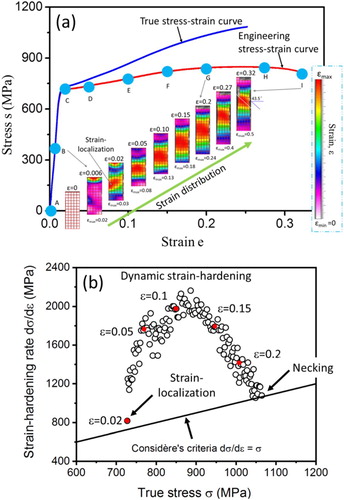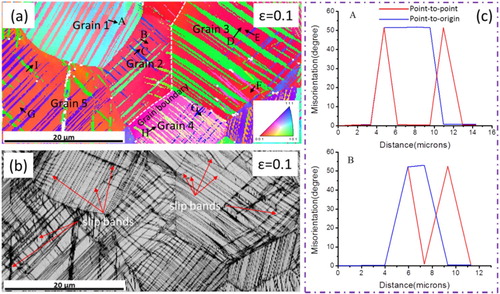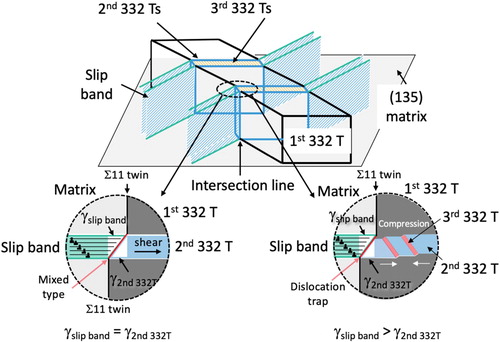Figures & data

Figure 1. (a) Engineering strain-stress curve and true strain-stress curve of ST sample. The 2D full-field strain maps and the corresponding max of tensile strain (defined as εmax) at different strain levels, as well as the bar of strain distribution, were also displayed in the inset of (a). The different strain levels were marked with the capital letter ‘A∼I’ in (a), respectively; (b) Strain-hardening rate vs true stress. The Considère’s criteria dσ/dε = σ line was also plotted in (b).

Figure 2. EBSD analysis of Ti-12Mo-10Zr sample at strain ε = 0.1. (a) IPF map. The deformation bands were also symbolled by capital letters ‘A∼I’ with arrows, respectively; (b) Image quality (IQ) maps. The traces of slip bands were also marked with red arrows; and (c) Misorientation profile along the arrows labelled A and B in (a) as typical examples.

Figure 3. TEM images of the hierarchical structure of triple 332 T. (a) Bright-field image of triple 332 T (Lower magnification overview); (b) Close-up bright-field image of selected-area b in (a): matrix (M), primary 332 T, secondary 332 T and tertiary 332 T. The traces in the matrix and primary 332 T analysed by the trace method [Citation14] were presented in (a). The selected-areas c, d, e and f were also highlighted by the dotted circle in (a) and (b); (c–f) SAED of selected-areas c, d, e and f, respectively. The zone axes (ZA) of the matrix is near [35]β, and the common ZA of [101]β is shared by primary, secondary and tertiary 332 T.
![Figure 3. TEM images of the hierarchical structure of triple 332 T. (a) Bright-field image of triple 332 T (Lower magnification overview); (b) Close-up bright-field image of selected-area b in (a): matrix (M), primary 332 T, secondary 332 T and tertiary 332 T. The traces in the matrix and primary 332 T analysed by the trace method [Citation14] were presented in (a). The selected-areas c, d, e and f were also highlighted by the dotted circle in (a) and (b); (c–f) SAED of selected-areas c, d, e and f, respectively. The zone axes (ZA) of the matrix is near [31¯5]β, and the common ZA of [101]β is shared by primary, secondary and tertiary 332 T.](/cms/asset/447c98d4-0910-48e2-8821-c8f043055249/tmrl_a_1745920_f0003_oc.jpg)
Figure 4. Schematic illustration of the 3D view and cross-sectional views concerning the formation sequence of primary 332 T, secondary 332 T and tertiary 332 T.

